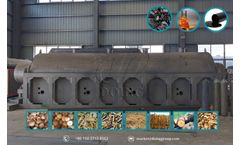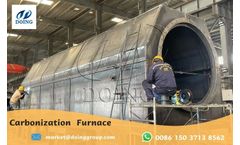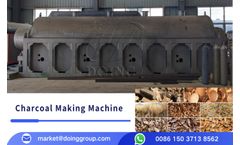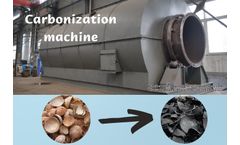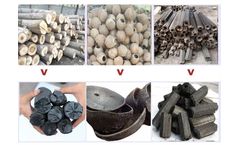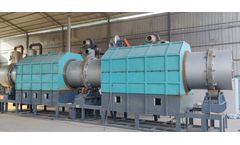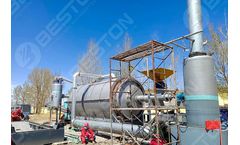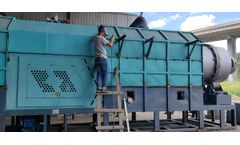Gas Emissions From The Combustion Articles & Analysis
115 articles found
Project Demonstrates High Potential for CHP in Food Processing Industry . Frito-Lay North America, Inc., a division of PepsiCo, installed a combined heat and power (CHP) system at its food processing plant in Killingly, Connecticut, in 2009. The installation was supported by a state grant under Connecticut's Energy Independence Act, which encouraged businesses and government agencies to install ...
Eastern Michigan University (EMU) is located in Ypsilanti, Michigan, approximately 35 miles west of Detroit and 8 miles east of Ann Arbor. It was founded in 1849 as a small teachers college and today has grown into a major public learning and research institution with over 21,000 students. EMU historically has been a leader in energy efficiency and sustainability. In 1987, the University ...
Vanderbilt University is a private research university of about 7,000 undergraduate and 6,500 graduate and professional students located in Nashville, Tennessee. The campus has 179 buildings across 341 acres and includes both university and medical facilities. To support this large campus, electric, heating and cooling utilities are provided and maintained by the plant operations department of ...
The University of Michigan (U-M) is a public research university. Founded in 1817, U-M is the oldest and largest university in Michigan. It was established 20 years before the territory became a state. Since 1871, U-M has been a coeducational institution. Today, it enrolls approximately 32,000 undergraduate and 16,000 graduate ...
Located in Boca Chica, a municipality of Santo Domingo, this project was initiated by the government of the Dominican Republic to address the increased need for on-demand peaking and emergency energy. This 190 MWe open cycle thermoelectric power plant consists of ten Power Generation Modules, PGM 130, powered by the Titan 130, and two Titan 250 gas turbine generator sets operating on natural gas, ...
With the global plastic waste crisis intensifying, finding sustainable recycling methods has become more urgent than ever. Traditional recycling approaches cannot handle the vast volume of non-recyclable plastics, while landfilling and incineration harm the environment. One promising solution is pyrolysis of plastic to oil, a process that transforms waste plastics into valuable fuels. Recent ...
Policy Drivers: Tightening Industrial Emissions Regulations The global industrial sector is experiencing unprecedented regulatory pressure to optimize combustion efficiency and reduce emissions. The European Union's revised Industrial Emissions Directive (IED 2024/1785), effective August 4, 2024, mandates stricter requirements for Large Combustion Plants (LCPs) including gas turbines and boilers ...
Making charcoal through a carbonization process in a plant involves heating organic materials, such as wood, in the absence of oxygen to drive off volatile compounds and leave behind carbon-rich material. This method is also known as pyrolysis and is applicable to various raw materials for producing biochar or charcoal, including but not limited to wood, fruit shells (such as coconut shells, palm ...
Charcoal is made by heating biomass waste such as wood and fruit shells in an oxygen-deficient or low-oxygen environment. This process is called carbonization. The carbonization process removes moisture, volatile substances and other impurities from the wood, leaving behind a substance that is almost pure carbon, namely charcoal. There are many materials available for making charcoal, which can ...
The biomass continuous carbonization furnace is an efficient and environmentally friendly equipment for the thermochemical conversion of biomass resources. The whole set of continuous carbonization furnace converts biomass into charcoal by controlling the temperature, pressure and gas of the carbonized material. The whole set of processing technology of the continuous carbonization furnace ...
CO poisoning occurs when fuel or gas combustion of residential gas furnaces and boilers is incomplete, leading to the production of the harmful CO gas. ...
Continuous carbonization furnace is an efficient and environmentally friendly equipment for the thermochemical conversion of biomass resources. The whole set of continuous carbonization furnace converts biomass into charcoal by controlling the temperature, pressure and gas of the carbonized material. The whole set of processing technology of the continuous carbonization furnace includes four ...
For our client in Birmingham we are working on an installation with direct port injection running on synthetic gas. With direct port injection of the gas into the combusting chamber of the engine, we expect to increase the efficiency of the synthetic gas with 5 to 10%. High temperature gas is injected after closure of the gas valve and with longer combusting time. This is resulting is prevention ...
ByDordtech
Charcoal production from coconut shells is a meticulous process that requires careful attention to detail and precision. Utilizing a coconut charcoal making machine, one can efficiently convert coconut shells into high-quality charcoal. This guide delves into the intricate steps involved in the production process, highlighting the significance of each stage. Understanding the Coconut Charcoal ...
Environmental Protection Agency (EPA) proposed new carbon pollution standards for coal and natural gas-fired power plants. The proposal would set limits for newly established gas-fired combustion turbines, existing coal, oil and gas-fired steam generating units, and certain existing gas-fired ...
The amount of raw materials used to produce one ton of charcoal is a concern of most investors. It is closely related to the investor's investment cost, production scale and final profit. In this article we will explore how many tons of raw materials are required to produce one ton of charcoal? Generally speaking, 70% to 80% of raw materials are consumed in the production process of charcoal, ...
Imagine a machine that transforms organic waste and abundant raw materials into valuable biomass charcoal. These versatile, eco-friendly machines are capable of processing 500 to 3000 kilograms of raw materials per hour. The range of materials they can handle is staggering, from wood chips, sawdust, and coconut shells to palm shells, olive shells, rice husks, and bamboo. Not to mention, they ...
Having a modern rubber pyrolysis plant, it's possible to convert used automobile tires into useful commodities, including fuel oil, combustible gas, and carbon black. Steel wire can even be obtained from scrap tires in this plant. ...
The two main varieties of charcoal making machine: batch type and continuous type. Both of them are easy to operate and install. They can be completely sealed to avoid dust from flying across the production area. They can process different materials and are utilized to create both dry and wet charcoal. As oil storage is becoming scarce worldwide, charcoal is a great fuel alternative. Charcoal is ...
Ever thought about exactly how the charcoal briquettes that you just accustomed to grill with were made? The answer is biomass carbonization. A biomass pyrolysis plant takes organic matter, including wood, and transforms it into a fuel source which can be burned for energy. Not only is this process environmentally friendly, additionally it results in a valuable product that can be sold ...




